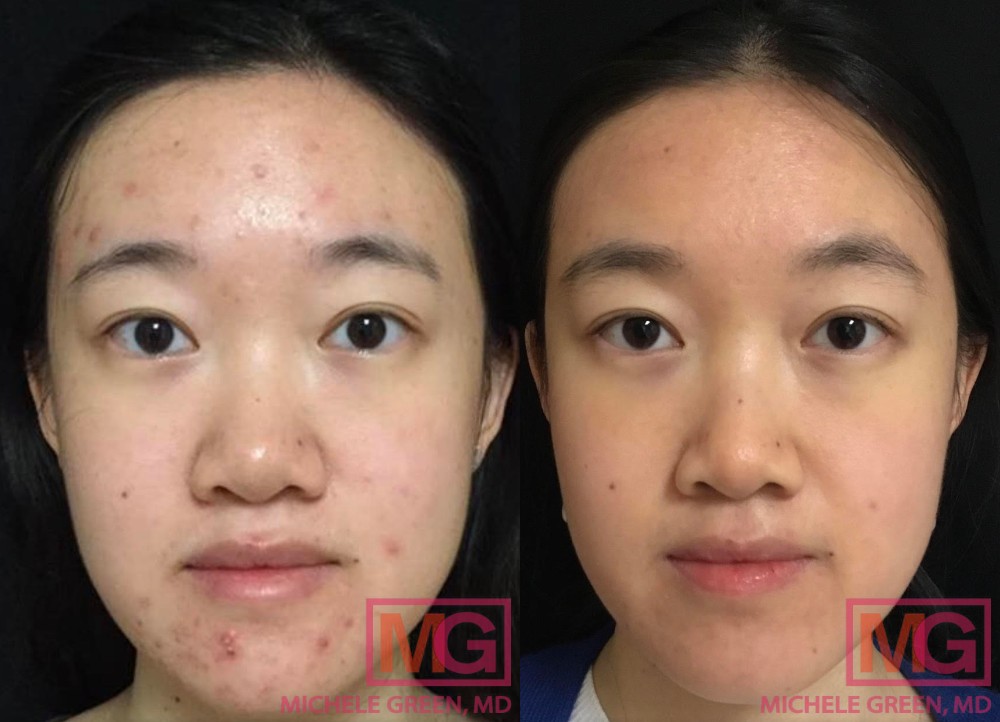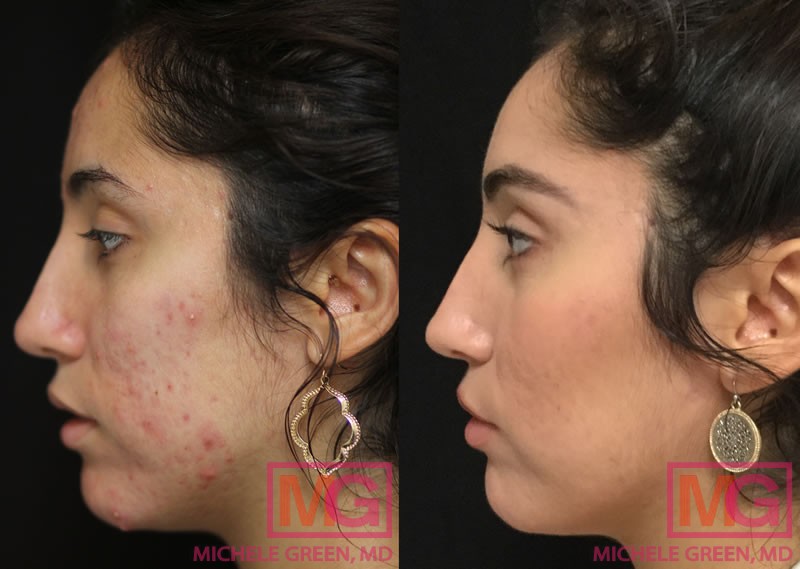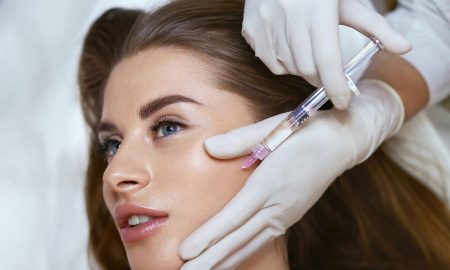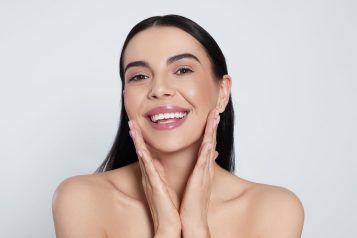Michele S. Green M.D., FAAD., is a Board-Certified Cosmetic Dermatologist, Fellow of the American Academy of Dermatology, and has been an international leader in cosmetic dermatology for over 25 years. Upper East Side patients and those around the globe flock to her practice for cosmetic dermatology treatment. A graduate from Yale University, with an MD and Chief residency from The Mount Sinai School of Medicine in NYC, Dr. Green treats some of the most discerning, demanding women and men in the world, with issues ranging from premature skin aging to hyperpigmentation, rosacea, wrinkles, acne, skin laxity, hair loss, and sun damage.
In the pursuit of flawless skin, many individuals find themselves battling the persistent and often challenging foe known as cystic acne. This severe form of acne can be a source of frustration and insecurity for those who suffer from it. Fear not, as Dr. Michele Green uncovers valuable tips and treatments that can help manage and alleviate the impact of cystic acne.

What is Cystic Acne?
Cystic acne is characterized by large, red, and tender bumps that don't come to a head. These pus-filled cysts form deep beneath the skin's surface, making over-the-counter treatments largely ineffective. Highly inflammatory, cystic acne is closely linked to scarring. Common treatments include oral antibiotics, Accutane (Isotretinoin), and Spironolactone. While topical treatments can complement oral medications, they usually lack the depth needed to clear cystic breakouts on their own. Despite this, using suitable skincare products remains crucial for acne-prone skin. Consulting with experienced dermatologists like Dr. Michele Green is key to effective treatment and prevention.
What Are The Causes Behind Cystic Acne?
Cystic acne emerges when sebaceous glands clog due to excess oil, bacteria, and dead skin cells, primarily affecting the face but potentially appearing on other oil gland-rich areas like the back, chest, buttocks, shoulders, and neck. Genetic factors and hormonal changes during puberty, pregnancy, menstruation, and menopause elevate the risk. Individuals with a family history of cystic acne face higher chances. While commonly associated with oily skin, acne cysts can develop in those with normal, dry, or combination skin. Genetic predisposition and hormonal imbalances play a significant role. Dr. Green, through a thorough assessment, medical history analysis, and potential lab tests, determines the cause of your acne for optimal treatment.
Acne vs. Cystic Acne: What Are The Differences?
Acne and cystic acne are both common skin conditions, but they differ significantly in terms of severity, underlying causes, and the nature of the lesions. Acne is a broad term that encompasses various skin blemishes, including whiteheads, blackheads, and pimples, typically caused by the overproduction of oil, clogged pores, and bacterial inflammation. Cystic acne, on the other hand, represents a more severe form characterized by deep, painful, and inflamed cysts or nodules beneath the skin.
Unlike regular acne, cystic acne involves the formation of large, pus-filled lesions that extend deep into the skin layers. While common acne can be managed with over-the-counter products and topical treatments, cystic acne often requires more aggressive interventions, such as prescription medications or dermatological procedures, due to its potential to cause long-term scarring and persistent discomfort. The key distinction lies in the intensity and depth of the lesions, making cystic acne a more challenging condition to address effectively.

Oral Medications: Your Ticket to Clear Skin
When it comes to tackling cystic acne, the expertise of a board-certified dermatologist like Dr. Green is crucial in determining the most effective oral medications tailored to your skin's unique needs. Cystic acne, often influenced by genetics or hormonal changes, may require oral interventions for lasting relief.
Oral Antibiotics: Doxycycline and Tetracycline emerge as powerful solutions for mild to severe cystic acne, especially when topical treatments prove insufficient. Dr. Green will customize the prescription based on the severity of your condition, emphasizing the importance of taking probiotics simultaneously to support gut health.
Oral Isotretinoin (Accutane): A groundbreaking treatment, Accutane, formerly reserved for severe cases, now addresses both moderate and chronic acne. Under Dr. Green's supervision, the medication prevents new nodules, minimizes scarring, and offers a more permanent solution. Monthly check-ups ensure safety, with dose adjustments and strict sun protection integral to the process.
Spironolactone (Aldactone): Targeting hormonal imbalances contributing to acne, Spironolactone, originally for blood pressure, proves effective in controlling androgen levels. Particularly beneficial for those with Polycystic Ovary Syndrome, it regulates sebum production, providing relief for acne-prone individuals.
Oral Contraceptives/Birth Control Pills: For women contending with hormonal fluctuations triggering acne, oral contraceptives like Yaz and Ortho Tri-Cyclen offer a solution. FDA-approved for treating hormonal breakouts, they balance hormones, but potential side effects include weight gain and mood swings.
Unveiling Radiant Skin Solutions for a Blemish-Free You
Chemical Peels: Experience skin rejuvenation through chemical peels, a non-invasive procedure promoting faster skin cell turnover. This process effectively removes dead skin cells and unclogs pores, revealing a more even complexion. Dr. Green tailors the peel's type and strength during your consultation to address specific concerns like hyperpigmentation, acne scars, and fine lines.
Acne Surgery: Combat active blemishes with acne surgery, an in-office procedure that opens acne lesions, removes contents, and administers corticosteroid injections. This quick technique reduces inflammation, minimizing the risk of acne scarring. While effective for current breakouts, it doesn't prevent new lesions. Dr. Green combines acne surgery with oral medications, topical treatments, and skincare products for a comprehensive approach to treating cystic acne.
VBeam Laser: Achieve facial redness elimination with the VBeam laser, targeting red pigment and killing acne-causing bacteria. This treatment stimulates collagen production, reducing breakouts and improving skin texture. With zero downtime, patients can resume daily activities immediately. The VBeam's dynamic cooling device enhances treatment comfort, making it an ideal solution for managing acne-related redness.
HydraFacials: Indulge in the three-step HydraFacial for gentle exfoliation, deep cleansing, and intense skin nourishment. Using a vortex fusion tip, this medical-grade facial first suctions away dirt and dead skin cells, then applies a chemical peel to boost skin cell turnover. The final step infuses antioxidants, reinforcing the skin's protective barrier. Customizable for various skin concerns, including acne, HydraFacials leave you with a radiant, glowing complexion.

Must-Have Topical Skincare Essentials
Revitalize your skincare routine for smoother, clearer skin with these essentials tailored to combat cystic acne. Begin with the Pore Minimizing Cleanser from MGSKINLABs, Inc., a potent combination of glycolic and salicylic acids targeting excess oil and unclogging pores. Hydrate with the Ultimately Sheer moisturizing lotion, a non-comedogenic solution ideal for acne-prone skin, preventing dryness and excessive sebum production. Sunscreen is a must—UV exposure can exacerbate cystic acne. Dr. Green's Hydrating SPF 50, a lightweight sunscreen from MGSKINLABs, Inc., provides broad-spectrum protection against UVA and UVB rays, streamlining your routine while prioritizing effective skincare.
The Power and Potential of Photodynamic Therapy
Photodynamic Therapy (PDT) is a cutting-edge medical treatment that harnesses the power of light and a photosensitizing agent to target and treat various skin conditions and certain types of cancer. The process involves applying a photosensitizer, often a light-sensitive drug, to the affected area, followed by exposure to specific wavelengths of light. This activation triggers a photochemical reaction that selectively destroys targeted cells or structures, such as abnormal skin cells or cancerous tissue.
In dermatology, PDT is commonly employed for treating conditions like actinic keratosis, acne, and sun-damaged skin. It offers a non-invasive alternative with minimal downtime, making it an attractive option for patients seeking effective and well-tolerated treatments. Additionally, PDT's versatility extends to oncology, where it is utilized in certain cases of skin cancer and precancerous lesions. The therapeutic potential of Photodynamic Therapy continues to expand, showcasing its role at the forefront of innovative medical interventions for various skin-related concerns.
How Can You Get Started with Treatment for Cystic Acne Today?
Whether your goals include addressing the severity and appearance of cystic acne or aiming for clearer, healthier skin Dr. Green in NYC can provide customized solutions to meet a wide range of aesthetic goals. Dr. Michele Green is an internationally renowned board-certified cosmetic dermatologist and is known to be one of the best Botox injectors in New York. Dr. Green has been consistently voted as one of the “Best Doctors” by Castle Connelly, New York Magazine, Super Doctors, and The New York Times as a pioneer in the field of cosmetic and medical dermatology. Please call the office today at 212-535-3088 or contact us online to schedule a consultation to discuss if you are a candidate for cystic acne treatments.
For more information, visit Dr. Michele S. Green's social media:






















